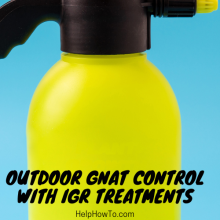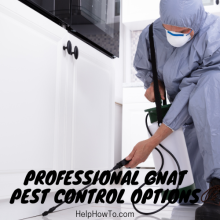Keep Gnats Out Of Your House By Sealing Openings | HelpHowTo
Summary of Keeping Gnats Out Of Your House By Sealing Openings
Gnats can be a pesky nuisance in homes, but sealing all potential entry points is one of the most effective long-term solutions. Gnats are tiny and can enter through the smallest cracks and openings that regular window screens can’t block. Sealing creates a physical barrier to prevent their entry, without using harmful chemical pesticides.
Thoroughly inspect inside and out for cracks around windows, doors, plumbing fixtures, vents, foundations, cabinets, and any utilities entering the home. Properly caulk and seal these openings, using appropriate interior/exterior materials. Combine sealing with eliminating moisture sources, keeping areas clean, using fans to deter entry, and traps for existing infestations. While sealing requires effort and some materials have odors, it’s an environmentally-friendly way to comprehensively exclude gnats. Incorporate sealing into regular seasonal home maintenance for lasting prevention of these pests.

Our Top 5 Recommended Indoor Genat Traps
Sick of pesky gnats invading your home? Discover the top 5 indoor gnat traps to banish these annoying insects for good! Our expert reviews reveal the most effective, easy-to-use traps. From powerful UV attractants to eco-friendly vinegar traps, we’ve thoroughly tested and ranked the best solutions. Check Now

Keeping Gnats Out: A Comprehensive Guide to Sealing Your Home
Gnats, those pesky little flies, can be a real nuisance in your home. They seem to appear out of nowhere, buzzing around and disrupting your peace. While there are various methods to get rid of gnats, one of the most effective and long-lasting solutions is to seal all potential entry points into your home. By doing so, you can prevent these tiny pests from ever gaining access in the first place. This guide will provide you with a comprehensive overview of how to keep gnats out by sealing openings, ensuring a gnat-free environment for you and your family.
The Importance of Sealing Openings:
Gnats are incredibly small, and they can squeeze through even the tiniest cracks and gaps. Unlike larger insects, regular window screens may not be enough to keep them out. By sealing all openings, you create a physical barrier that gnats cannot penetrate, eliminating their ability to enter your home. This approach is not only effective but also environmentally friendly, as it doesn’t involve the use of chemical pesticides, which can be harmful to humans and pets.
Identifying Potential Entry Points:
Before you can effectively seal your home, you need to identify all potential entry points for gnats. This requires a thorough inspection, both inside and outside your home. Look for cracks and gaps around windows, doors, plumbing fixtures, vents, and any areas where utilities enter the home. Don’t forget to check the foundation, siding, and areas around cabinets and appliances in the kitchen and bathrooms, as gnats can exploit even the smallest openings.
Sealing Windows and Doors:
One of the main entry points for gnats is through windows and doors. Start by inspecting the frames carefully, feeling for any drafts that indicate cracks or poor seals. Caulk all cracks and gaps, ensuring a tight seal. Replace any damaged weatherstripping and install new screens if necessary. Pay special attention to the areas where the frames meet the walls and floors, as these can be common entry points for gnats.
Sealing Other Openings:
In addition to windows and doors, you’ll need to seal any other openings in your home. Use high-quality caulk or sealant to fill cracks and holes in walls, foundations, and around pipes and wires entering the home. Cover vents, such as attic, soffit, dryer, and bathroom vents, with fine mesh screens to prevent gnat access. Don’t overlook any potential entry point, no matter how small it may seem.
Caulking and Sealing Tips:
Proper surface preparation is crucial for effective sealing. Clean and dry the areas thoroughly before applying caulk or sealant. Choose the appropriate product for interior or exterior use, as well as the right material for the job, such as latex, silicone, or polyurethane. Have the necessary tools on hand, like caulk guns and putty knives, and follow the recommended application techniques for best results.
Other Gnat Prevention Steps:
While sealing entry points is a crucial step in keeping gnats out, it should be part of an integrated approach. Eliminate any moisture issues, such as leaks or standing water, as gnats are attracted to damp environments. Keep your home clean and free of organic debris, which can serve as a breeding ground for gnats. Additionally, using fans near entry points can deter gnats from entering by creating air currents that make it difficult for them to fly.
Dealing with Existing Gnat Problems:
If you already have a gnat infestation inside your home, sealing entry points alone may not be enough. Use traps and baits to help reduce the existing gnat population while you work on sealing the openings. Identify and remove any potential breeding sites, such as overripe fruits, spilled liquids, or organic matter accumulations. In severe cases, it may be necessary to call in a professional pest control service.
Potential Downsides and Considerations:
While sealing openings is an effective and environmentally friendly way to keep gnats out, it does require time and effort. Depending on the size of your home and the number of entry points, the process can be labor-intensive. Additionally, some caulking and sealing materials may have strong odors or require proper ventilation during application. It’s also important to note that sealing alone may not be a complete solution if there are existing gnat breeding sites within your home or if there are recurring moisture issues that attract them.
Conclusion:
Keeping gnats out of your home by sealing openings is a practical and long-lasting solution. By following a thorough process, identifying and sealing all potential entry points, and combining this approach with other preventive measures, you can significantly reduce the chances of gnat infestations. Remember, sealing should be part of your regular home maintenance routine, especially during the warmer months when gnat activity is at its peak. With patience and diligence, you can enjoy a gnat-free living environment and reclaim your peace of mind.

Our Top 5 Recommended Indoor Genat Traps
Sick of pesky gnats invading your home? Discover the top 5 indoor gnat traps to banish these annoying insects for good! Our expert reviews reveal the most effective, easy-to-use traps. From powerful UV attractants to eco-friendly vinegar traps, we’ve thoroughly tested and ranked the best solutions. Check Now
FAQs and Answers
How often should I inspect and reseal entry points around my home?
Here are some recommendations on how often to inspect and reseal entry points around your home to keep gnats out:
Inspection frequency:
- Do a thorough inspection at least twice per year – in early spring and early fall. This allows you to seal up before peak gnat/insect seasons.
- Also inspect after any home renovation projects that may have created new cracks/gaps.
- Check areas prone to caulk/weatherstripping deterioration more frequently (every 2-3 months).
Resealing frequency:
- Reseal any newly discovered cracks or failed sealant applications immediately.
- Most good quality caulking/weatherstripping lasts 5-10 years before needing replacement in a typical climate.
- High heat/sun exposure areas may need resealing every 2-3 years.
- Consider resealing the entire home perimeter every 5 years as part of maintenance.
By inspecting thoroughly twice per year at minimum and resealing as needed, you can stay ahead of potential new gnat entry points around your home. Don’t wait for an obvious gnat problem to check for cracks and failed sealant.
Are there any legal or building code requirements I need to follow when sealing openings in my home?
Yes, there are some legal and building code requirements you may need to follow when sealing openings in your home to keep gnats out:
Building Codes:
Many residential building codes have specific requirements around ventilation and not completely sealing off certain openings related to:
- Attic ventilation – You cannot fully seal attic vents as proper airflow is required to prevent moisture buildup.
- Crawlspace vents – These vents must remain unobstructed for cross-ventilation.
- Dryer vents – Codes prohibit sealing dryer exhaust ducts which need air flow.
- Plumbing vents – Vent pipes for plumbing need to remain open to outside.
So while you can use mesh covers or reduce vent openings, you cannot completely seal off code-required vents.
Fire Safety:
There are fire code regulations about not obstructing or sealing windows that could be emergency egress routes in a fire. All operable windows must remain accessible.
Use Approved Materials:
Any caulks, sealants or other materials used around windows, doors, electrical boxes etc. should be approved for that application and meet fire rating requirements.
So in general, you have flexibility to seal air leaks and pest entry points, but not in a way that violates fire, ventilation or egress codes. Check with your local building authorities for specific regulations before any major sealing projects.
What do I do if I seal an entry point but gnats are still getting in?
If you’ve sealed what you thought were all potential entry points but gnats are still managing to get into your home, here are some troubleshooting steps to take:
- Re-inspect thoroughly
Go over every window, door, vent, crack, and crevice again carefully. Gnats can squeeze through extremely small openings. Use a bright light and mirror to check for any missed gaps, failed sealant, or overlooked entry points. - Check for internal sources
Sometimes gnats can start breeding inside if there are moisture problems like leaks, spills, or organic matter buildup. Inspect bathrooms, kitchens, houseplants, and any damp areas as a potential internal source. - Inspect at different times of day
Gnats may be entering at certain times like dawn/dusk when you’re not around to notice. Monitor various times to see if you can catch where they’re coming from. - Use detection tools
Food-based gnat traps placed in different areas can help pinpoint hot spots and travel patterns to locate persistent entry points. - Re-seal and use exclusion methods
Once any new suspected openings are found, re-seal them. Also try using additional exclusion methods like weatherstripping, door sweeps, ventilation filters, and window screens. - Bring in a professional
If you cannot locate the access points after thorough re-inspection, consider hiring a pest control professional to do a more intensive evaluation and sealing.
Perseverance is key, as a single overlooked gap is all gnats need to keep entering. Systematic re-checking and combining sealing with other exclusion methods is usually required.
Can sealing openings cause poor ventilation or moisture buildup issues in my home?
Yes, overly sealing openings in your home can potentially lead to poor ventilation and moisture buildup issues if not done properly. Here are some key points to consider:
Ventilation Concerns:
- Homes need a certain amount of air exchange and ventilation to prevent indoor air quality problems.
- Sealing up too many vents, windows, and other openings restricts airflow and ventilation pathways.
- This can lead to stuffiness, odors, high humidity levels, and buildup of indoor pollutants.
Moisture Issues:
- Proper ventilation helps control moisture levels inside the home.
- If there is insufficient air exchange, moisture from cooking, showers, etc. can accumulate.
- Excess moisture can lead to mold growth, wood rot, musty odors, and other issues.
Building Code Violations:
- As mentioned earlier, many building codes require specific vents and openings for attics, crawlspaces, appliances, etc.
- Completely sealing off code-required vents is a violation that can trap moisture.
To avoid these problems when sealing against gnats and pests:
- Don’t seal up all ventilation openings – leave appropriate vents and air pathways.
- Use mesh screens over vents rather than sealing them closed.
- Consider adding ventilation fans if sealing significantly reduces airflow.
- Monitor for any moisture buildup after sealing and address accordingly.
- Follow all building codes for required vents and openings.
The goal is to seal cracks and entry points for pests, while still allowing adequate overall ventilation and moisture control in the home. Finding the right balance is key.
How much does it typically cost for materials and labor to professionally seal a home against gnats?
The cost for professional sealing of a home against gnats can vary significantly depending on several factors:
Materials Cost:
- Caulk/Sealant – $3-$10 per tube, may need 10-20 tubes for an average home
- Weatherstripping – $0.25-$1 per linear foot, 200-400 ft. for doors/windows
- Mesh Vent Covers – $10-$50 each
- Expanding Foam Sealant – $5-$10 per can
- Other Materials (putty, tools) – $50-$100
Estimated Materials Cost Range: $200 – $600
Labor Cost:
- Typically charged by the hour or job
- Average labor rates – $35-$65 per hour or $300-$1000 per job
- Time Required – 1-3 days for thorough sealing of an average home
Estimated Labor Cost Range: $300 – $1,500
Other Potential Costs:
- Repairs (replacing damaged window screens, etc) – $100-$500
- Exterior Scaffolding/Lifts for 2nd+ Story – $200-$1,000 rental
- Follow-Up Service/Warranty – 10-15% of initial cost
So for an average 2,000 sq.ft. single-family home requiring 1-2 days of labor, the total professional gnat sealing cost could range from:
Low End: $500 (just basic materials and labor)
High End: $3,000+ (more extensive repairs, equipment, follow-up included)
Most homeowners can expect to pay $1,000 – $2,000 for a thorough professional sealing job to exclude gnats and other pests. The exact price depends on the size of the home, condition, materials used, and the wildlife/pest control company. Many provide free evaluations to give a custom quote.

Our Top 5 Recommended Indoor Genat Traps
Sick of pesky gnats invading your home? Discover the top 5 indoor gnat traps to banish these annoying insects for good! Our expert reviews reveal the most effective, easy-to-use traps. From powerful UV attractants to eco-friendly vinegar traps, we’ve thoroughly tested and ranked the best solutions. Check Now





